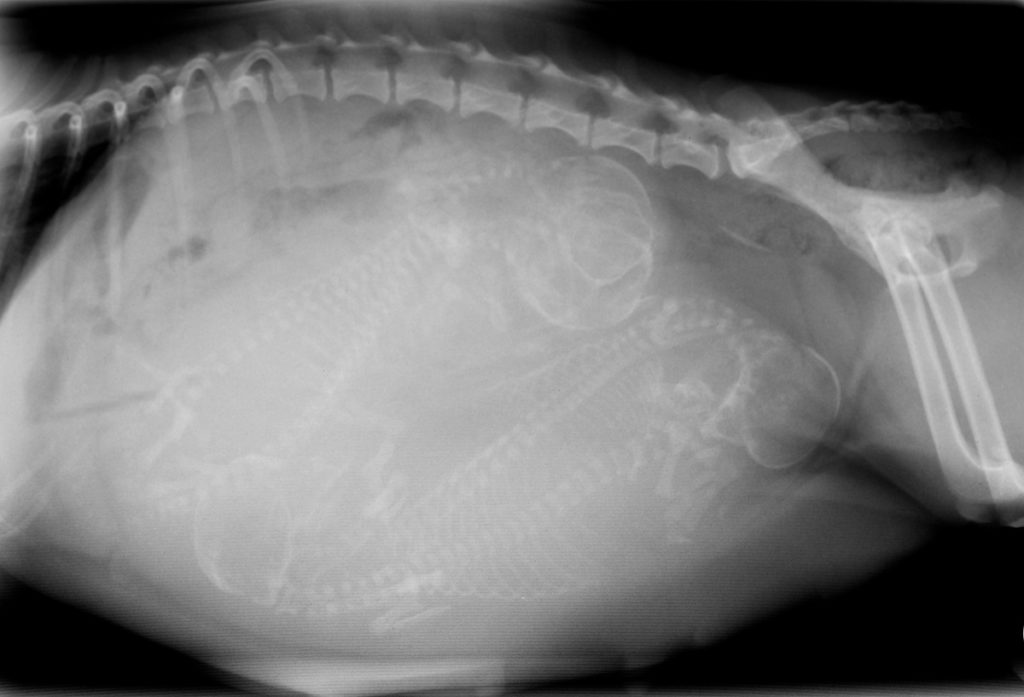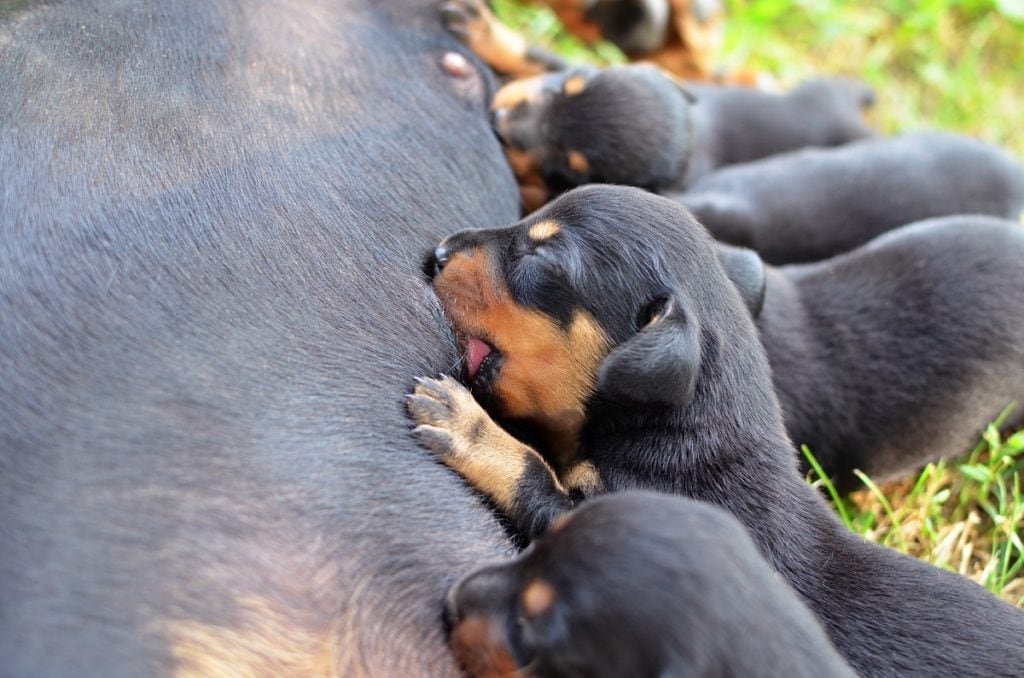Although I’m a huge proponent of adopting dogs and cats from shelters or animal rescues, I still find that watching the birth of a litter of puppies is an amazing experience. When I was a little girl, my parents raised German shepherd puppies. I can still remember the smell of their puppy breath, the sounds of their grunting and whining, and the overwhelming feeling of holding those floppy little puppies in my arms.
However, a child’s perspective is much different from the reality of being the adult pet parent.
Let’s go over a few things you should keep in mind to ensure a pleasant delivery. A new litter of healthy puppies begins with a healthy mom, so nutrition is the most important aspect to take into account.
Pottenger’s Cats sums up a ten-year study of nutrition conducted by Dr. F.M. Pottenger Jr., a doctor of human medicine. Pottenger was concerned about heat-labile nutrients in food that were available in the raw form but destroyed during the cooking process. From 1932–1942, Pottenger conducted a multigeneration nutrition study to determine the effects of heat-processed food on 900 cats.
The study shows the effects of consuming denatured foods (similar to many of today’s over-processed and malnourished kibble). Pottenger details the physical and emotional problems that developed in the animals placed on a cooked diet—problems that never transpired in those consuming the raw cat food. The cooked-diet cats never got past the third generation because they became infertile and lost the ability to reproduce.
That said, what should you feed a pregnant mom? Well, let’s get back to nature. Variety is key. Start by talking to your veterinarian about the best brand of food for your dog as well as how much food they require based on their breed, age, and stage of pregnancy.
A healthy, well-fed pregnant dog will gain about 15–20 percent beyond her weight at breeding. Dogs are typically pregnant for 63 days. And, like humans, their pregnancy is divided into trimesters. Overfeeding should be avoided as it can result in obesity at the end of pregnancy, which increases the risk for difficult or prolonged labor and places extra stress on the puppies. On the other hand, underfeeding during pregnancy can result in embryo loss, abnormal fetal development, spontaneous abortion or stillbirth, small litter size, and low birth-weight puppies that fail to thrive.
As a guideline, choose a highly digestible, palatable diet that is high in protein, fat, and minerals. Also supplement with Standard Process Canine Whole Body Support and Canine Immune Support (both are available in a feline version as well), along with Calcifood wafers. The Canine Whole Body Support is a broad-spectrum nutritional supplement (multivitamin, multimineral, enzymes, and trace nutrients) and supports the entire endocrine system. This is essential because the mother’s endocrine system is working full speed to support the pups, while at the same time the pups’own endocrine systems are developing. In my opinion, this is a critical supplement for pregnant animals.
As the name suggests, Canine Immune Support provides nutritional immune-system support for both mother and pups. It promotes a strong immune response in the colostrum and helps the pups get a good start.
Last but not least, Calcifood wafers consist of cold-processed bone meal and offer a fully balanced source of minerals as they occur in the body. Keep in mind that minerals found in whole foods do not contribute to mineral imbalances. SP supplements offer whole-food nutritional support that helps fill in the gaps we most often see.
There are very few visible signs in the first trimester, so you may not notice much of change in your dog’s appearance or behavior other than some weight gain. Pregnant dogs can get morning sickness, but only for a few days during the third or fourth week. They may seem tired, and they may eat less than usual. Some dogs throw up a little. (If yours does, offer her small meals over the course of the day.)
By the end of the second trimester, your pregnant dog’s belly will get bigger. Around this time (by day 40), her nipples will begin to get darker and larger. As the due date approaches, her breasts will enlarge, and a little milky fluid may trickle out.
Your vet will likely suggest that you come back at the start of the third trimester (around day 45) to take X-rays of your dog’s belly. This can be used to check on the bone structure of the growing puppies. By counting their skulls and spines, your vet can figure out how many puppies will be in the litter. This is a really exciting time!
During the last two weeks of pregnancy, you may see and feel the growing puppies moving inside mom’s belly. Now is the time to get ready for the birth (whelping). You want it to be as comfortable and hassle-free as possible. The best way to do this is to set up a whelping box, which offers a safe, warm, comfortable, and easy-to clean location for your dog to have her puppies. If you do not provide her with a safe place for whelping, she may decide to deliver someplace else—like your closet or outside under the porch.
This whelping supply checklist will help make sure you have everything you need:
- Newspaper or potty pads to line the whelping box during delivery
- Dry, clean towels to clean the puppies
- Paper towels to help with general clean up
- Thermometer to check your dog’s temperature before whelping
- Unwaxed dental floss to tie off the umbilical cords
- Clean scissors to cut the umbilical cords
- A heating pad or hot water bottle to keep the puppies warm (make sure it’s not too hot)
- Iodine to clean the puppies’ abdomens after the umbilical cord is cut and to dab on the end of the cut cord
- Ribbons to mark each puppy
- Your veterinarian’s phone number and the number of a nearby emergency clinic
Delivery time is coming when you see signs of labor. Your dog may stop eating a few days before whelping, and she may start trying to build a “nest” (hopefully in the whelping box). She may start to pant heavily. Shortly before labor, her temperature will drop from around 100–102.5°F down to 99°F or even lower.
Approximately 24 hours after her temperature drops, she will begin to whelp. Unlike humans, dogs generally give birth easily and do not require assistance. Your role is to assist when necessary. Each puppy is born enclosed in its placental membrane. Ideally, the mother will tear the placenta open, sometimes eating it. If she doesn’t, you will have to remove it as puppies cannot survive for more than a few minutes before their supply of oxygen runs out. Also make sure that each puppy’s airway is clear if mom doesn’t start licking and cleaning the new baby.
Mom should also sever the umbilical cord as she cleans her pups. If not, it’s up to you to snip the cord and tie it off with some unwaxed dental floss (about one or two inches from the puppy). Wipe each puppy’s belly with iodine to prevent infection from entering through the umbilical cord. Within five to fifteen minutes after each birth, a mass of blackish-green tissue called the placenta, or afterbirth, should follow. It is important to keep track of the number of placentas as a retained placenta can cause problems for the mother.
You will know that mom is done delivering when all the puppies that showed up in the X-ray or ultrasound are accounted for. If you didn’t get one prior to delivery, the best way to know when whelping is over is to look at the mother’s behavior. She should be very relaxed and resting while taking care of her puppies. If there have been no more pups after 2 hours, she is likely done. Your dog and puppies should be examined by a vet within 24 hours of birth, even if they appear healthy. And if it’s a cold season, you can always get some pet clothes to keep them warm once they’ve grown a bit.
Being prepared and knowing what signs of trouble you should be alert for is key to a successful delivery. When in doubt, contact a veterinarian with questions.
Images from iStock/Ирина Мещерякова (main), tbob (dog Xray), Smederevac (puppies).

